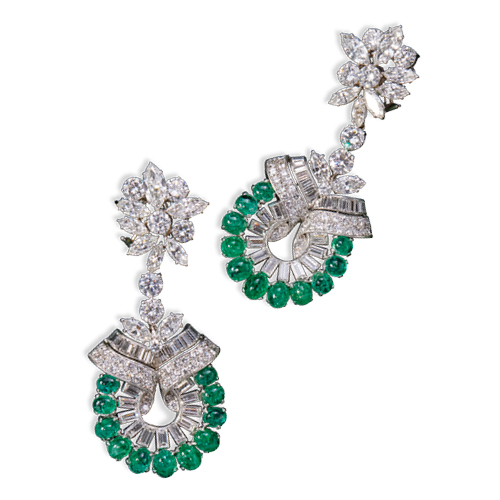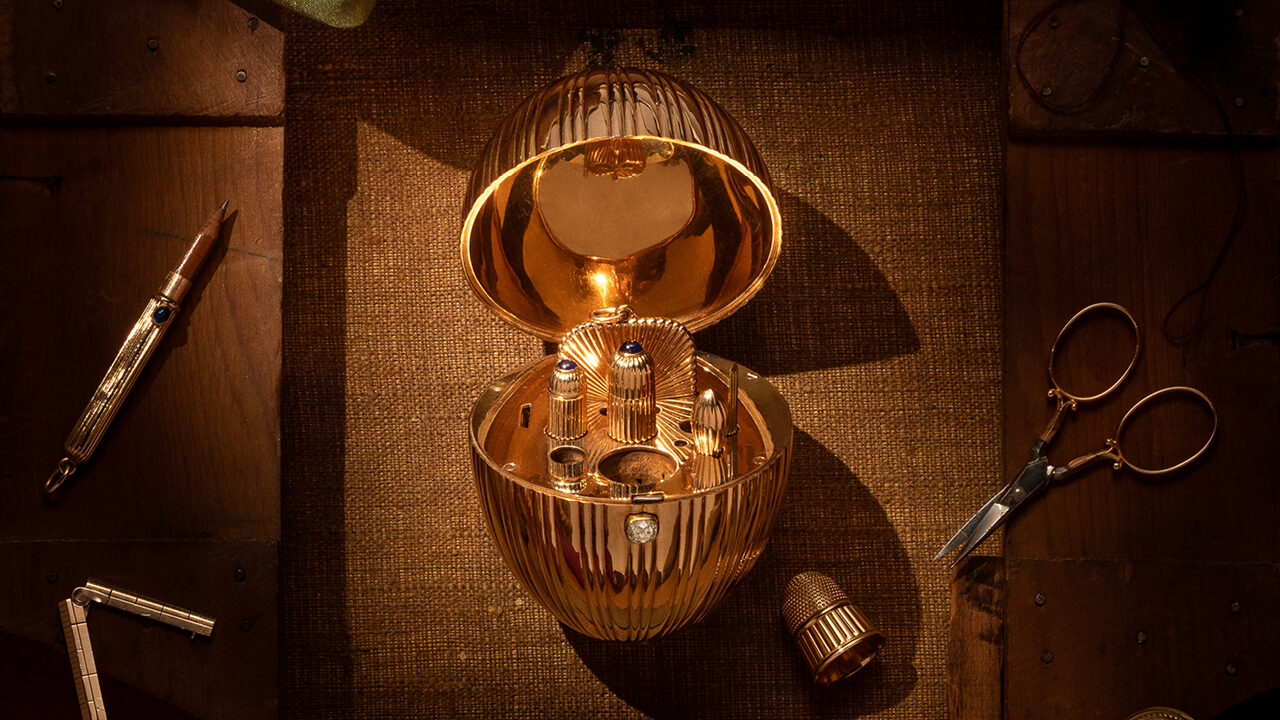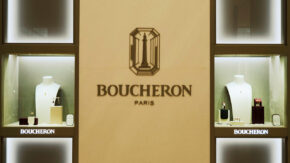A frequent buyer of fine jewelry from Farber Auctioneers & Appraisers recently shopped her tony private collection around to higher-profile houses to sell, but ultimately gave the job to the two-year-old jewelry-only outfit in Lambertville, New Jersey. The move was a coup for the fledgling firm and speaks to why some smaller auctioneers are stealing work away from bigger-name competitors.
“She got estimates from the larger houses but didn’t like their turnaround times or fees,” explains Farber co-owner Sasha Krivitsky. “She trusted us — so much so that she didn’t even want to wait for an auction and took our quote for immediate payment.” Further sweetening the deal was Farber’s policy of waiving consignment fees — such as commissions or repair and cleaning costs — for any previous shoppers, though Farber did charge a buyer’s premium fee.
While many think of Sotheby’s and Christie’s for sales of natural colored diamonds or famous private collections like film icon Elizabeth Taylor’s, a growing number of clients are warming up to the idea of entrusting more approachable auction houses with finding their heirlooms a new home.
Rooting for the underdogs
One of the biggest auction misconceptions is that hammers drop only for million-dollar gems; in reality, designer silver jewelry, lesser-known makers, and even nonprecious collections are selling at houses that may not have crossed your radar.
Dianne Batista spent 10 years working at a big house before joining Rago Auctions, which is also in Lambertville. The now-director of fine jewelry and watches knows firsthand that her new employer treats pieces under $20,000 differently than her prior one did. “A $14,000 piece becomes important for our auctions,” she says. “We give it ads and coverage, whereas it might be overlooked in a larger house.”
There are many reasons to consider consigning jewelry to a lower-profile auction house. It can offer more fee flexibility and personal attention, including access to jewelry department heads. Smaller houses are also super interested in the backstory behind your jewels and will often use it to build interest in sales.
A $14,000 piece becomes important…. We give it ads and coverage.
Emily Waterfall is the director of the Bonhams jewelry department, and managed to carve out an art-jewelry niche thanks to a client. A collector approached the UK-based international auction house two years ago with her own 1,500-piece collection from legends like mid-20th-century jeweler Art Smith.
Unlike auction houses’ usual precious jewelry fare, art jewelry often consists of nonprecious materials like brass or paper. However, Bonhams took a chance on the commission, and the sale was a success. “Now we have a strong buying presence for art jewelry,” she says.
Lourdes Winnick appreciates the rich histories of single-owner collections, which is why her employer, Freeman’s Auctions in Philadelphia, Pennsylvania, loves to sell them. Winnick heads the jewelry and watch department there, as well as the luxury handbags and accessories department. At press time, she was enthusing about the upcoming March auction of philanthropist Dianne Kay’s collection. “Jewelry with a story always does better,” she says, noting that she and her staff can put more resources into supporting those collections.
And don’t discount a house just because it seems regional; its reach is likely more expansive than you realize. For example, Freeman’s will rent an office in New York if it feels buyers might be there. And although the headquarters of auctioneer Hindman is in Chicago, Illinois, the company has staffers in 15 different offices nationwide, including New York and Milwaukee, Wisconsin.
Sally Klarr, director and senior specialist of Hindman’s jewelry and watches department, also worked at a big house in the past and knows the importance of being local. “We are regionally based; we live in their communities,” she says of areas like Detroit, Michigan, and San Diego, California. “And I’ll fly across the country to meet with a potential client, even if they don’t have six figures to sell.”
What to look for
When deciding on an auction house, it’s important to consider factors like fees, turnaround times, the kinds of marketing it will do, and the frequency and types of auctions on offer.
Fees can vary widely, from consignment and buyer’s fees to photography, insurance, restocking and buy-back charges. Nearly all the houses in this article say their consignment fees are negotiable and can start as low as 10% of the final achieved price, while other houses operate on a sliding scale based on the value of the goods.
Also ask about the sell-through rate and payout dates. Some houses make clients wait months to receive sale proceeds, while some smaller establishments can get it done sooner because they don’t need to deal with a massive corporate infrastructure.

diamond, and
14-karat white gold
earrings that once
belonged to socialite
Dianne Kay and sold
at Freeman’s
in March.
“Our payout is 30 days,” says Farber’s Krivitsky. “And our sell-through rate is 90% when we help the seller choose a starting price.” If a piece still fails to sell, the house will either keep trying, or purchase the item at the starting price it suggested.
Promotions can include e-blasts to existing clients, social media marketing, ads in major metropolitan publications, postcard mailings, and the occasional world tour. Ahead of its March auction of a private collection from southern California, Bonhams sent the jewels to outposts in San Francisco, Los Angeles, Hong Kong, and Scottsdale, Arizona, with the final sale taking place in New York.
Auction types vary as widely as the houses’ office locations. Some hold weekly online sales starting at $500, while others have monthly or triannual auctions of higher-priced items. Participants can bid in person, online, or by phone. Some houses offer a buy-it-now feature, letting people purchase select pieces at a set high price without bidding.
“We’re trying to give lots of options,” explains Jill Burgum, executive director of fine jewelry at Heritage Auctions in Dallas, Texas. “The public is often afraid of auctions.”
Burgum is also no stranger to creative problem-solving. When a client approached Heritage with an array of loose gems that didn’t fall into any set category, she started a new one: melee auctions. “Our first one was last year,” she relates. “It was all diamonds, and everything sold. We’re having another one in June.”
Perhaps the best type of auction is an emotion-packed one. In 2018, Fortuna Auctions in New York sold the estate of socialite and TV host Bokara “Bo” Legendre, which featured jewels from Belperron and Cartier, among others. As part of its promotion, Fortuna CEO Herbert John Saxon helped organize an event with Rolls Royce and luxury hotel The Surrey. The New York Times wrote an obituary about Legendre. By the time the live auction took place, these efforts had generated a frenzy of interest, paving the way for a 100% sell-through rate and a final intake of more than $1.6 million.
“The auction room was so packed that we were breaking fire codes,” Saxon recollects. When the last hammer fell, Saxon saw the estate executor stand up in the front row, sobbing with mascara streaming down her face. She walked over to him and gave him a big hug. “That validated our efforts and may be the most powerful moment of any auction we’ve conducted in 11 years of business,” he says.
This article is from the March-April 2023 issue of Rapaport Magazine. View other articles here.
Image: Antique Russian yellow gold and diamond nécessaires sold at Hindman for $275,000. (Hindman)



